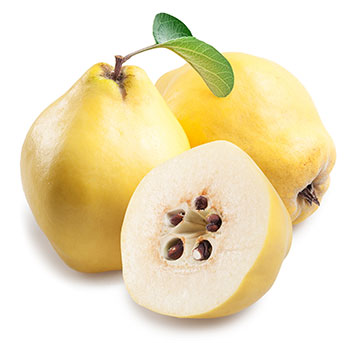After writing about the various types of citrus and their uses I thought about using other fruits as medicine. My mind turned to quince, since our wild lemon tree looks very similar to it. However, quince is not in the same family as citrus, Rutaceae (the rue family), but in Rosaceae, shared with apples and pears. The raw fruit is hard and unpalatable, but when cooked the flesh turns a brownish pink and has a pleasant flavor. There are lots of recipes using it throughout the ages and its typical use is as a food. I knew the Chinese used quince medicinally but what about Western quince?
Western Quince
Native not only to rocky slopes and woodland margins in Southwest Asia, quince (Cydonia vulgaris) is also indigenous to Turkey and Iran (as far back as Persia and Anatolia). Later it spread to Greece and of course from there to Europe and America. There’s lots of lore around quince. Sacred to Aphrodite, it was this fruit that Paris awarded to her. It was also the golden quince for which Atalanta paused in her race.
However, Western quince is quite different than that which grows in the East. The immature fruit is green with a dense grey-white pubescence, most of which rubs off before maturity in late autumn when the fruit changes to a golden yellow color. It’s long been used in jams and jellies, of course, but also as medicine, too.
Listed in Grieve’s A Modern Herbal (from 1931), it is demulcent, astringent and antidiarrheal. The fruit may be made into syrup and taken for diarrhea. The seeds are very mucilaginous and taken internally treat diarrhea and inflammation of the gastrointestinal tract.
Topically, the seeds make a good compress, poultice, ointment, or lotion for burns, chaps, ulcers, cuts, and to soothe the eyes. It can also be used as a mouthwash or gargle for mouth and throat inflammations.
Some people use common quince (Cydonia oblonga) interchangeably with C. vulgaris for digestive disorders, diarrhea, coughs, and gastrointestinal inflammation.
Homeopathic Quince
Quince is also a homeopathic remedy. Called cydonia, it’s used to strengthen the stomach and male sexual organs. It’s particularly used for penis enlargement by removing any infection in the prostate that can lead to this condition. (I know, “What dose?” you immediately ask!) Normally it comes in a 30C potency.
Chinese Quince
The Chinese quince (Chaenomeles langenaria) is also known as “flowering quince.” It is more like a bush of canes and has red fruit. Also in the Rosaceae family, it’s called mu gua in Chinese and has a warm energy, sour flavor and enters the Liver and Spleen channels. It is considered an herb to dispel Wind-Damp conditions, particularly in the joints and extremities. The dried fruit is used to move the Blood through the channels, relax the muscles and tendons, transform Dampness and harmonize the Stomach. It is anti-rheumatic, anti-inflammatory, laxative, analgesic, and astringent.
Chinese quince is especially effective for the lower limbs, treating ligament pains, congestion of the blood and nerve channels, weakness in the lower back and extremities, severe cramping pains, abdominal pains, spasms of the calves, and swelling of the legs. It also unblocks food stagnation, similarly to hawthorn berries.
It is generally not given to those with heat and is taken in decoction using 3-12g.
Japanese quince (Cydonis japonica) is grown mainly as an ornamental for its red flowers.

